
Comment on today’s post for the chance to win a copy of Laurie Bishop’s January release, LORD RYBURN’S APPRENTICE. Comments may be posted to the end of today, Saturday, January 14th!
Whoa…here we are, near the end! I’ve been wracking my brain trying to think of something half as intelligent as the other ladies, and I finally decided that, since we are about “Risky Regencies” after all, I should do something with Risky Characters.
It is almost expected that the characters of a traditional regency should be genteel—respectable if not of nobility. (Yes—I already hear the disagreement, but I’m speaking in general, not of the notable and exciting exceptions). Okey-doke. Let’s do this….
Here are some ideas for some Regency characters that would not typically make your average hero or heroine.
During the Regency, the poor were moving from the country to town largely due to the effect of enclosure, the law that gave ownership of the land to a few and therefore ended the common ownership of land by a community. With no land for sustenance farming, the city seemed the best place to survive. Of course, the conditions of the poor in the city were very bad indeed, BUT there were things you could do to make a living.
If you were at all educated with acceptable personal appearance, habits, and ambition, you might become a maid or manservant in a good household. These jobs were difficult, but there were much, much worse things you could do. Other jobs were as shop assistants, trade apprentices, street sellers, street sweepers, and joining the navy (voluntarily or otherwise). There were seamstresses who worked for long hours in poor conditions, rat catchers (who killed rats bare-handed, or sold them at the local pub for use in a rat-pit—to be the prey of ferocious dogs, for entertainment), and scavengers.
Still worse was the use of children in a variety of trades—children sold into trade as orphans or by their parents—and some of the uses children were put to could be very unsavory indeed. There were, of course, the chimney sweeps, which everyone has heard of. There were also children who were put into prostitution or to work as pickpockets.
Of course, many adults turned to illegal means to survive, of which prostitution and thievery were only two. I mentioned grave-robbing in an earlier post, for instance. Gambling was epidemic—men, and sometimes women, would bet on anything, even their own lives. And there was an assortment of scams—rather like an early version of the Internet.
One scam I can think of was one where a woman of ill repute teamed up with a male partner or two and would seduce a gentleman into coming to her chamber. Likely he was drunk, but be as it may, he would be assaulted, handily dispatched, and when he came to he would discover all of his possessions and his clothing gone.
Then there were characters who would live the life of a gentleman, charming their way through life with empty pockets, living on loans and outrunning their creditors, sometimes getting lucky at a gaming table and sometimes spending time in prison, sometimes seducing a daughter of some man of moderate fortune, and counting on luck to see them through.
We must not forget the high-class courtesans, of course…and some of them lived, and survived, very well—but many did not continue in good circumstances as age took its toll.
Let me get to the point of this monologue…a question. If you could chose your character from any walk of life except that of a well born someone…who would that character, male or female, be? Do you have any idea how your character might escape his or her position? It would be very difficult, but we have the means to find a way for our characters!
Alternate question: If you had to be one of these persons, who would you be? Or, who might you have been in a previous life?
Pick your poison…er, your question!
Laurie
LORD RYBURN’S APPRENTICE
Signet January 2006
P.S. You can still comment on earlier posts until the end of today, to win books by other Riskies. And don’t forget to enter the Treasure Hunt!

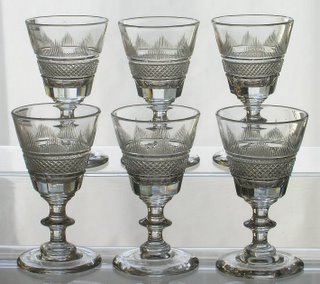 An Englishman liked his drink. Gin, rum, and brandy was the ordinary fare, found in pubs and taverns across England. One could not trust the water, after all, and water did not rouse the spirits half so well.
An Englishman liked his drink. Gin, rum, and brandy was the ordinary fare, found in pubs and taverns across England. One could not trust the water, after all, and water did not rouse the spirits half so well.
 circa 1770 with a very inter-esting swirled stem. You may notice that the bowl is not very big; in formal dinners where there might be numerous toasts, one could not get “potted” after the first two.
circa 1770 with a very inter-esting swirled stem. You may notice that the bowl is not very big; in formal dinners where there might be numerous toasts, one could not get “potted” after the first two.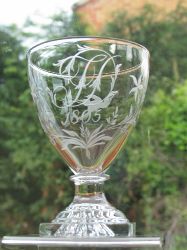 seems many have survived, since I found quite a few examples for sale on the internet.
seems many have survived, since I found quite a few examples for sale on the internet.
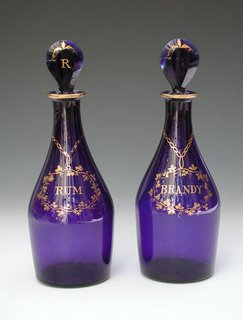
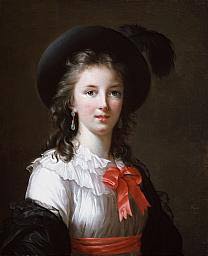


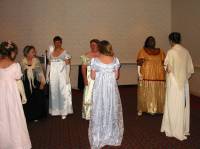

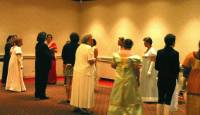
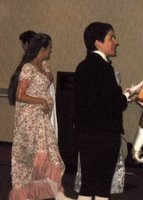
 I truly love this gown. I believe she said it was made by a seamstress in India—but my memory could be failing me. It doesn’t show well in this small picture, but it is a figured material–there are tiny blue flowers all over it.
I truly love this gown. I believe she said it was made by a seamstress in India—but my memory could be failing me. It doesn’t show well in this small picture, but it is a figured material–there are tiny blue flowers all over it.

